iPad mini Review
by Anand Lal Shimpi & Vivek Gowri on November 20, 2012 6:10 PM ESTGPU Performance
Although most of the industry has done a great job in pushing CPU performance forward, Apple remains largely uncontested when it comes to mobile GPU performance. This isn't really due to some unsurmountable advantage, but rather a willingness to spend on SoC die area and incorporate big GPUs into its designs. The graphics IP all comes from Imagination Technologies, and although it's very well integrated by Apple, there are other SoC vendors that could push the envelope here - they simply have chosen not to.
Things are beginning to change as we saw with the introduction of Qualcomm's Adreno 320 based Snapdragon S4 Pro. NVIDIA's Wayne (Tegra 4?) SoC is expected to be much more competitive on this front as well.
As a result of many of the competing devices using slower GPUs, the mini looks a lot better in our GLBenchmark tests than its competitors.
We'll start out with the raw theoretical numbers beginning with fill rate:

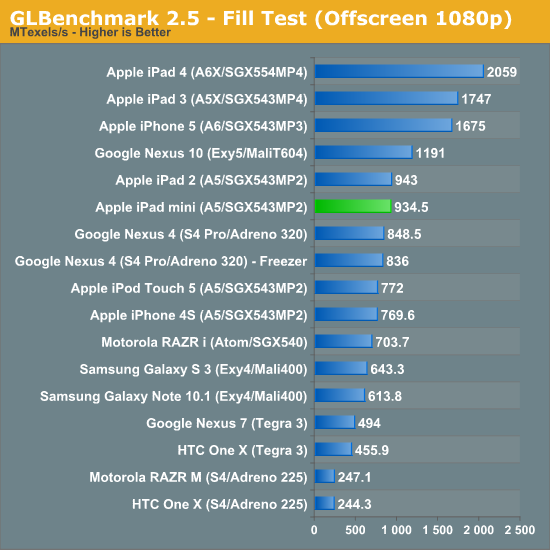
Other than the Nexus 10, the only devices that outperform the iPad mini here are other iPads or the iPhone 5. The mini's low native resolution will help ensure that gaming performance remains high for any currently available content.
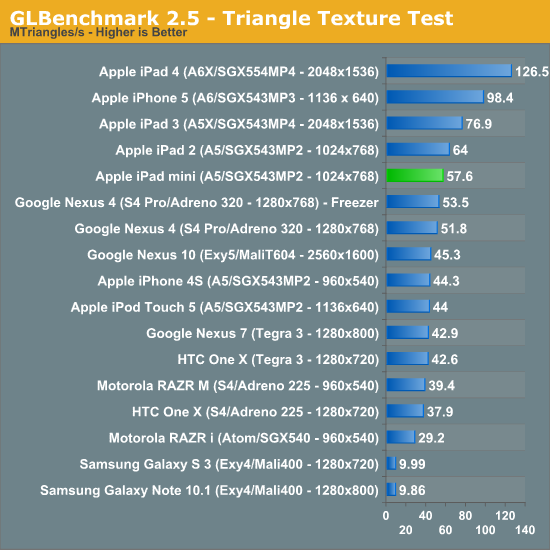

Triangle throughput looks very good here although the Tegra 3 based Nexus 7 is able to pull ahead on the offscreen test.
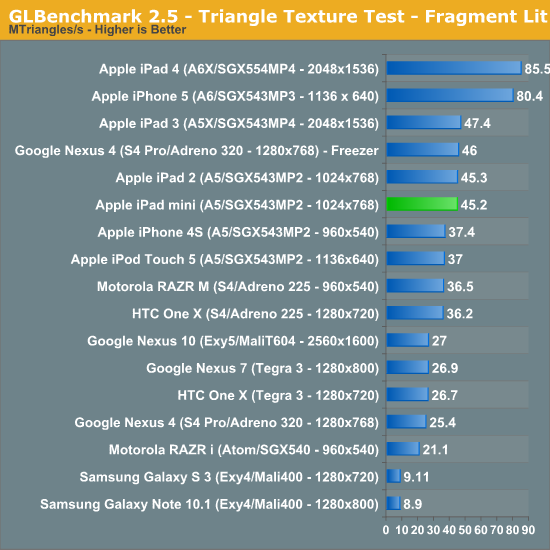
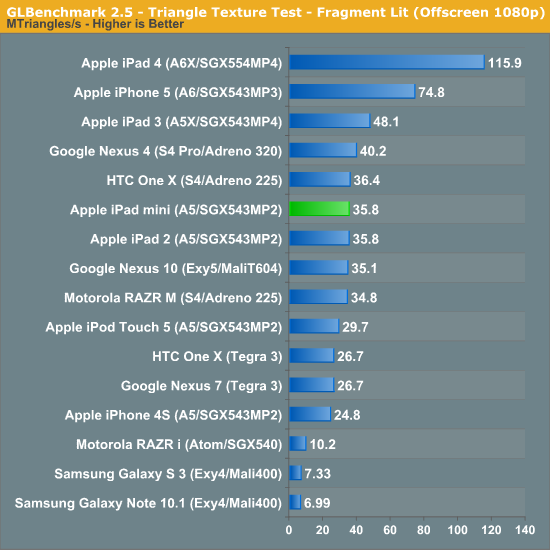
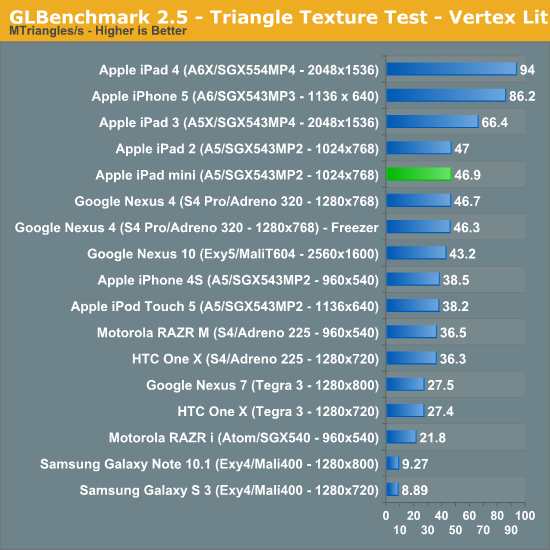
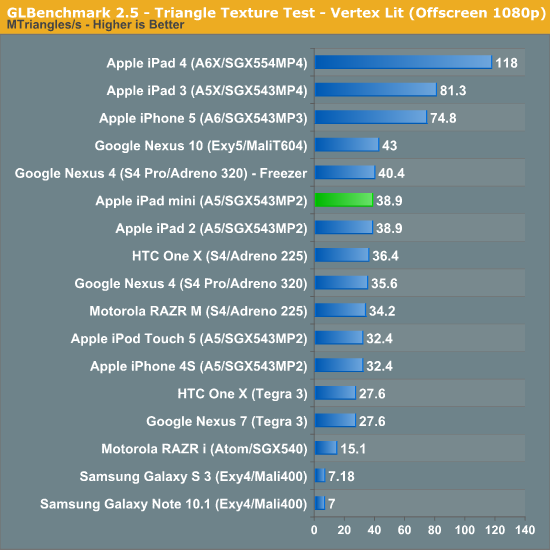
The mini continues to do quite well here vs the competition, although in the heavier triangle tests we see a clear difference between it and the A5X/A6/A6X based iOS devices.
With the synthetics out of the way, we can look at simulated game performance using the Egypt HD and Egypt Classic benchmarks. Remember the on-screen tests are run at native resolution with v-sync enabled, while the offscreen tests are run at 1080p with v-sync disabled for an architectural apples-to-apples comparison.
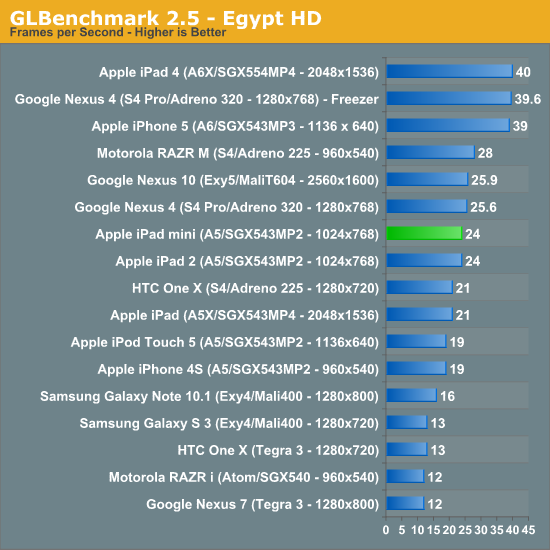
The mini does reasonably well running Egypt HD, which is a good indicator of future gaming performance on the device (perhaps ~2 years out for high end titles). The iPad 4's GPU does a good job of keeping up with its insane display resolution. The Nexus 7 doesn't fare nearly as well. Tegra 3 manages to run most current games just fine, looking forward though the GPU will probably not age too well.
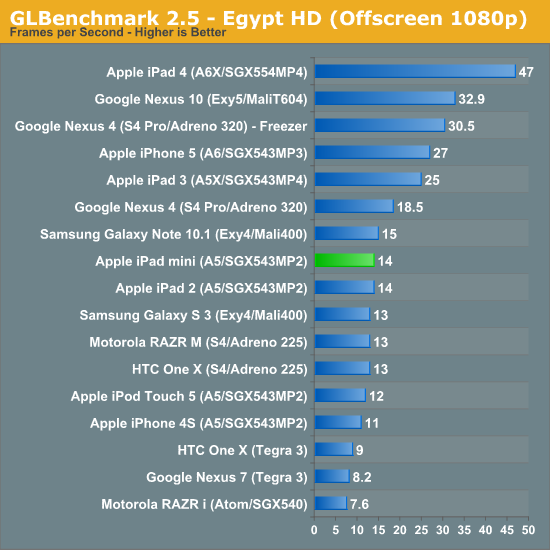
The offscreen tests show us what everything is really capable of given equal footing, and here the mini looks a lot more middle-of-the-road.
The Egypt Classic test is a much lighter workload, as a result most of these devices hit 60 fps at their native resolution:
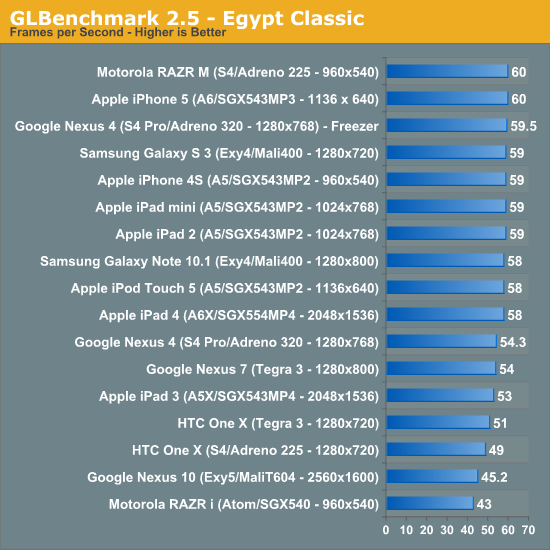
Although Egypt HD is a bit overkill for today's games, Classic undershoots by a good amount. The offscreen test however does provide some guidance as to whether or not these devices would be able to hit 30 fps on an appreciably heavier workload:

The mini does a good job here, although the iPad 3/4 and iPhone 5 are clearly quicker.
Overall the mini isn't a performance slouch. If you thought the iPad 2 was fast enough, the mini won't dissappoint. Its GPU remains very good and should be able to handle both present and upcoming iOS games. That being said, if Apple remains true to its typical cadence and gives next year's mini an A6 SoC I think that will end up being a much better match of price/performance.










140 Comments
View All Comments
daar - Wednesday, November 21, 2012 - link
Who manufactures the display? I recall in reviews of old this was mentioned, would be nice to see in future reviews of anything with displays this info, thanks.zepi - Tuesday, November 20, 2012 - link
Since the current-gen ipad-retina-displays are pretty abysmal in terms of power usage (see displaymate's measurements for example), would it be unreasonable to expect LTPS or IGZO panels to make things considerably better?Apple uses Low-Temperature polysilicon IPS in iphone for a reason and it's said that the forthcoming IGZO's would help in power consumption as well.
I think that Ipad 4 is a "failure" as it doesn't address any of the shortcomings of the 3rd Gen ipad. Namely weight, thickness and reasonably poor visibility in direct sunlight. Though Apple just decided it's not worth the tradeoff to use A6 instead of A6x to reduce the battery weight by a tiny margin.
doobydoo - Wednesday, November 21, 2012 - link
Firstly - the iPad 4 isn't a 'new iPad' as much as the iPad 3 was - it's an upgrade a partial way through the year, so it shouldn't be expected to address all 'the shortcomings'.Secondly - the iPad 4 doubles the GPU power which addresses the single biggest issue with the iPad 3 - the underpowered GPU. It's significantly faster than any other tablet (as is the iPad 3).
Also it was important to get all the devices using the lightning connector.
Alucard291 - Wednesday, November 21, 2012 - link
Yeah its the newer new ipad >.>Also known as the biggest ripoff apple has yet produced. Lightning connector (differently shaped usb 2.0), not-really-upgraded soc which brought nothing for the end user. Right? Because iOS is always super smooth? Or is it not?
Wait wait wait and you're also saying that having even more unused gpu power is a shortcoming that was addressed? Well no point arguing with such logic.
Especially since the cpu is already outdated. A9's (even with a custom memory controller) are so 2011.
Man you are a MASTER of facepalms. You initiate a wave of them with every post of yours.
NCM - Wednesday, November 21, 2012 - link
Alucard291 writes: "Lightning connector (differently shaped usb 2.0)"Bzzt! Wrong.
Thanks for playing, come back when you've done your research properly.
Jorange - Tuesday, November 20, 2012 - link
Why did you zoom in on the Anandtech website on the Nexus 7, whilst the iPad mini is zoomed out, it makes the Nexus look like it can't display a full webpage which it can!! Subtle Anti-Android bias strikes again.ChronoReverse - Tuesday, November 20, 2012 - link
I don't know about bias (I like to attribute ignorance over malice) but it seems particularly bad that not only is the N7 zoomed in compared to the Mini, but it's zoomed in so much that the N7's image is larger than the Mini's.I can see zooming so that they're physically the same size (but then the N7 would be using more pixels to render the same thing) but it's not even at that level.
michal1980 - Tuesday, November 20, 2012 - link
because Anand's bias is showing.Still waiting for this rumored 'Anandtech' windows 8 review. But OMG look a small ipad, the site owner himself reviews.
Might as well start renaming the website 'appletech'
Ryan Smith - Tuesday, November 20, 2012 - link
Our Win8 performance guide will be done this week. We're not doing a massive review (that would mostly be rehashing our significant DevPrev and ConPrev articles) will hit all the high points.And note that what Anand does has no bearing on Win8. AnandTech is more than one person, and in this case since I'm the OS guru it's my article.
michal1980 - Tuesday, November 20, 2012 - link
I'm just disapponted that a site I've trusted and visted for years, is changing focus.if its an apple thing, there are tons of in depth reviews done right away, product, os, accessories etc etc.
windows is now becoming the abandoned step child.
look at this, pages of writing, that could be summed up in 2 words:
smaller ipad.